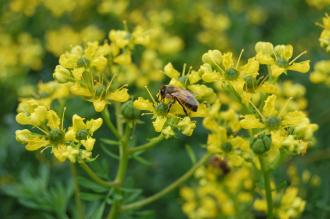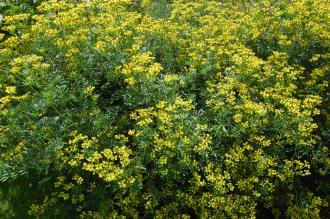
Ruta graveolens Flower (30/06/2012, Kew gardens, London)
Position: Full sun to light shade
Flowering period: Early summer
Soil: Moist, well drained
Eventual Height: 60cm
Eventual Spread: 60cm
Hardiness: 6b – 11
Family: Rutaceae
Ruta graveolens is a rounded, evergreen, sub-shrub. Its blue/ green leaves are bipinnate. or tripinnate, each leaflet being spatulate with entire margins and they extremely fragrant if crushed. Its yellow flowers have up to five petals, are borne in cymes and up to 1cm across. Its fruit is a five lobe capsule, this contains many seeds.
Ruta graveolens, commonly known as Common Rue, Garden Rue, Witchbane or Herb-of-Grace, is native to the Balkan Peninsula and has naturalised over much of the Mediterranean region. In its native habitat it grows on dry hillsides, usually on limestone. It has a long history of medicinal and culinary use. The consumption of a large amount of this plant will cause a number of medical complications, even death. Exposure to the essential oils of this plant in combination with sunshine may cause blistering on the skin of some individuals. Cats find this plant unattractive.
The etymological root of the binomial name Ruta is from the Latin meaning ‘bitter’. Graveolens is derived from the Latin grave meaning ‘ oppressive’, in reference ti the bitterness of this plant.

Ruta graveolens (30/06/2012, Kew gardens, London)
The landscape architect may find Ruta graveolens useful as an interesting informal hedge, both in color and texture. Once established it is drought tolerant once established.
Ecologically, R. graveolens is attractive to pollinating insects. Its leaves food for the caterpillars of butterfly.
The Royal Horticultural Society has given R. graveolens their prestigious Award of Garden Merit in 1993.
R. graveolens prefers moist, well-drained soils. It tolerates most pH of soil. It will tolerate nutritionally poor soils.
Ruta graveolens requires little maintenance.

